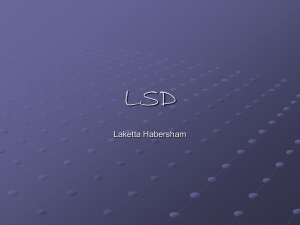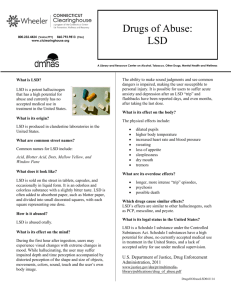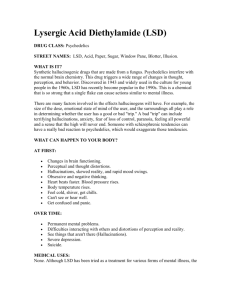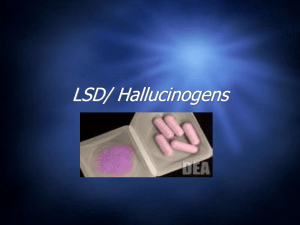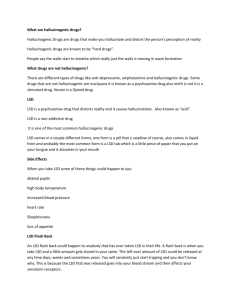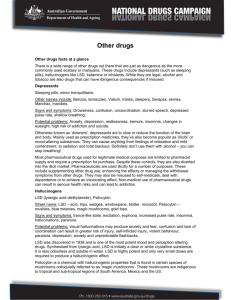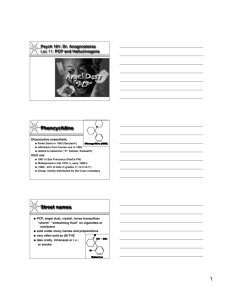LSD - msjilekpsych
advertisement
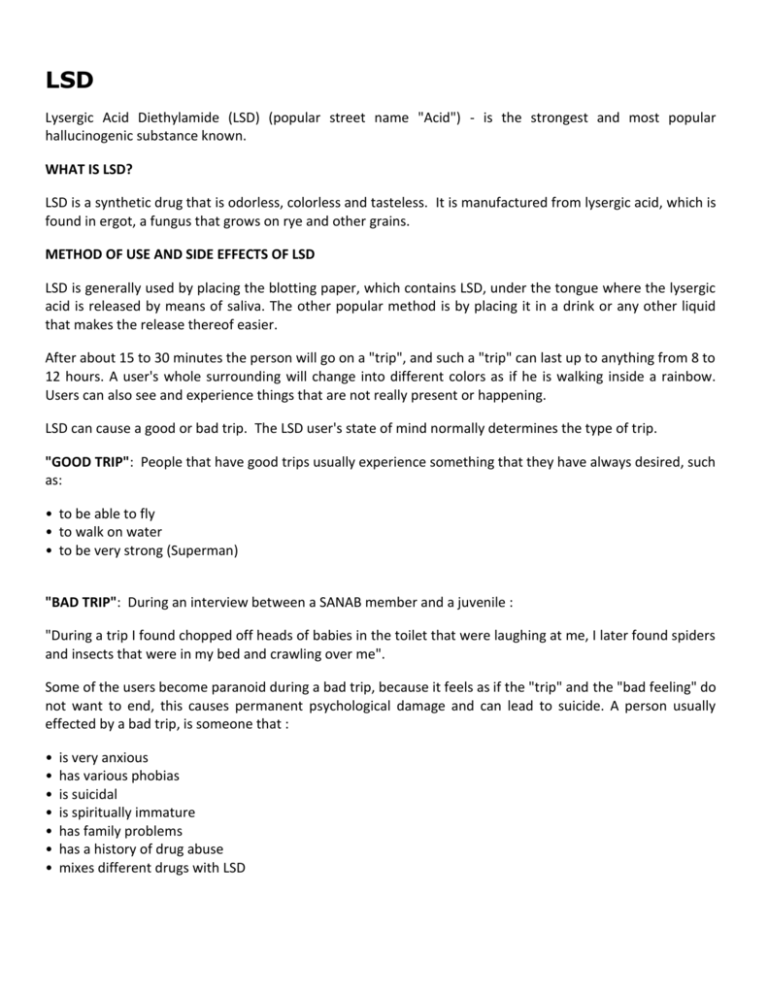
LSD Lysergic Acid Diethylamide (LSD) (popular street name "Acid") - is the strongest and most popular hallucinogenic substance known. WHAT IS LSD? LSD is a synthetic drug that is odorless, colorless and tasteless. It is manufactured from lysergic acid, which is found in ergot, a fungus that grows on rye and other grains. METHOD OF USE AND SIDE EFFECTS OF LSD LSD is generally used by placing the blotting paper, which contains LSD, under the tongue where the lysergic acid is released by means of saliva. The other popular method is by placing it in a drink or any other liquid that makes the release thereof easier. After about 15 to 30 minutes the person will go on a "trip", and such a "trip" can last up to anything from 8 to 12 hours. A user's whole surrounding will change into different colors as if he is walking inside a rainbow. Users can also see and experience things that are not really present or happening. LSD can cause a good or bad trip. The LSD user's state of mind normally determines the type of trip. "GOOD TRIP": People that have good trips usually experience something that they have always desired, such as: • to be able to fly • to walk on water • to be very strong (Superman) "BAD TRIP": During an interview between a SANAB member and a juvenile : "During a trip I found chopped off heads of babies in the toilet that were laughing at me, I later found spiders and insects that were in my bed and crawling over me". Some of the users become paranoid during a bad trip, because it feels as if the "trip" and the "bad feeling" do not want to end, this causes permanent psychological damage and can lead to suicide. A person usually effected by a bad trip, is someone that : • • • • • • • is very anxious has various phobias is suicidal is spiritually immature has family problems has a history of drug abuse mixes different drugs with LSD SIDE EFFECTS OF LSD The physical effects include dilated pupils, higher body temperature, increased heart rate and blood pressure, sweating, loss of appetite, sleeplessness, dry mouth, and tremors. Sensations and feelings change much more dramatically than the physical signs. The user may feel several different emotions at once or swing rapidly from one emotion to another. If taken in a large enough dose, the drug produces delusions and visual hallucinations. The user’s sense of time and self changes. Sensations may seem to “cross over,” giving the user the feeling of hearing colors and seeing sounds. These changes can be frightening and can cause panic. The most common side effect of a person using LSD is a change in personality. There are cases where persons suffered from severe paranoia as well as psychological deflection. LSD also has the side effect of staying in the body for a very long period. This can cause a person to go on a LSD trip again when it is later released in the bloodstream. This is known as a "Flashback" or recurrence of certain aspects of a person’s experience. A flashback occurs suddenly, often without warning, and may occur within a few days or more than a year after LSD use. HISTORICAL BACKGROUND LSD is surely the drug of the past decades that has taken on the imagination of people in drug cults, writers and even psychologists. This substance was very popular in the 60's during the "Hippie" era. The substance's doubtful advantages were praised in many a song during this period. Some of the well-known songs were "Lucy in the sky with diamonds" by the Beatles and "Purple Haze" and "Are you experienced" by Jimmy Hendrix. LSD was discovered for the first time in 1938 by Dr. Albert Hoffman. Dr. Hoffman was experimenting on a fungus, known as Argot, which is found on rye-grass. Dr. Hoffman wanted to use LSD as a medical cure for respiratory and systemic circulation sickness. During the 1940's and the mid 70's LSD was used on an experimental basis to established if it would help with the cure for certain mental illnesses. It was however found that LSD had serious side effects on certain persons, especially persons that suffered from cases of schizophrenia. LSD was used on various occasions by the USA Army as a chemical assault method. US researchers for the Army noted that LSD “is capable of rendering whole groups of people, including military forces, indifferent to their surroundings and situations, interfering with planning and judgment, and even creating apprehension, uncontrollable confusion and terror.” Experiments in the possible use of LSD to change the personalities of intelligence targets, and to control whole populations, continued until the United States officially banned the drug in 1967.
